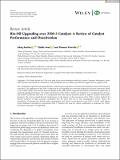| dc.contributor.author | Kariim, Ishaq | |
| dc.contributor.author | Swai, Hulda | |
| dc.contributor.author | Kivevele, Thomas | |
| dc.date.accessioned | 2024-06-06T08:14:53Z | |
| dc.date.available | 2024-06-06T08:14:53Z | |
| dc.date.issued | 2023-12-27 | |
| dc.identifier.uri | https://doi.org/10.1155/2023/4776962 | |
| dc.identifier.uri | https://dspace.nm-aist.ac.tz/handle/20.500.12479/2711 | |
| dc.description | This research was published by Hindawi International Journal of Energy Research,Volume 2023 | en_US |
| dc.description.abstract | Due to population explosion and industrialization, waste biomass and polymer conversion into biofuel has attracted the interest of researchers. The application of the ZSM-5 catalyst for bio-oil upgrading into renewable biofuels has attracted researchers’ efforts as an excellent catalyst. The need for improved biofuel quality with reduced oxygenates has further necessitated the application of catalyzed upgrading techniques. The catalytic performance of the ZSM-5 catalyst was attributed to its exceptional pore structure and window architecture and when it is incorporated with some selected transition metals to improve aromatic hydrocarbon formation. The review revealed that the development of coke deposit on the microspores of the ZSM-5 catalyst hindered the effective transport of large molecular compounds into the active sites for an easy deoxygenation process. Hence, the introduction of mesoporosity, hybrid catalyst development, and tailored crystal growth on the ZSM-5 catalyst could address several hindrances associated to conventional ZSM-5. Therefore, the need for catalyst modification is paramount for ZSM-5 performance during bio-oil upgrading. | en_US |
| dc.language.iso | en | en_US |
| dc.publisher | wiley | en_US |
| dc.subject | Research Subject Categories::NATURAL SCIENCES | en_US |
| dc.title | io-Oil Upgrading over ZSM-5 Catalyst: A Review of Catalyst Performance and Deactivation | en_US |
| dc.type | Article | en_US |

